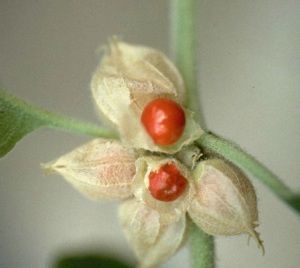
Nijemegen, B. J. (n.d.). Withania somnifers. Retrieved from: http://www.oocities.org/eagal14u/WithaniasSomnifera.html
Botanical name: Withania somnifera
Common Name: Ashwagandha, “Indian Ginseng”, Winter Cherry, Ajagandha, Karaj Hindi, Saam Al Ferakt (Ven Murthy et al., 2010, Abstract).
Family: Solanaceae (Ven Murthy et al., 2010, Abstract)
Part used: Root, leaves and bark (Bone & Mills, 2013, p. 949)
Active constituents: Ashwagandha contains steroidal alkaloids and lactones, which together are known as “withanoilides” (Ojha & Arya, 2009, p.156).
Origin: Native to South Asia, Central Asia and Africa, Ashwagandha is traditionally used in ayurvedic medicine (Ven Murthy et al., 2010, Abstract)
Qualities: Described as “medharasayan” in Ayurvedic medicine, which means ‘promoter of learning and memory revival’ (Bone & Mills, 2013, p. 949)
Actions
- Adaptogen (Bone & Mills, 2013, p. 949; Ven Murthy et al., 2010, Abstract)
- Anti-inflammatory (Bone & Mills, 2013, p. 949; Mishra et al., 2000, p. 335; Wollen, 2010, p. 231)
- Anti-tumor, antiproliferative (Bone & Mills, 2013, p. 949; Mishra et al., 2000, p. 335)
- Anti-stress (Mishra et al., 2000, p. 335; Wollen, 2010, p. 231)
- Antioxidant (Mishra et al., 2000, p. 335; Wollen, 2010, p. 231)
- Immunomodulator (Bone & Mills, 2013, p. 949; Mishra et al., 2000, p. 335)
- Hematopoietic (Mishra et al., 2000, p. 335)
- Mild sedative (Bone & Mills, 2010, p. 949)
- Tonic (Bone & Mills, 2010, p. 949)
Indications:
Rheumatologic conditions and Musculoskeletal disorders
Bone and Mills discuss the traditional indication in India and the Middle East in rheumatic pain (2013, p. 949). Mishra suggests that Ashwaganda’s use in rheumatologic conditions is likely a result of the herbs anti-inflammatory properties (2000, p. 335) and that the herb is indicated in variety musculoskeletal conditions (2000, p. 334).
Anxiety and Stress related physiological effects
Bone & Mills state that Ashwaganda indication in both anxiety and pathology associated with negative impact of stress is supported by clinical trials (2013, p. 949). Ashwaganda has been trialed for it’s assistance in the treatment of anxiety with some positive results (Bhattacharya, Bhattacharya, Sairam & Ghosal, 2000, Abstract). A recent randomized control trial found that Ashwaganda reduced symptoms of stress (Wollen, 2010, p.231).
Cardiovascular Disease
Withanolides of Ashwaganda have demonstrated cardiotonic activity including increasing contractively and relaxation, and decreasing preload (Ojha & Arya, 2009, pp. 156-157). While studies surrounding around Ashwaganda’s cardiovascular effects are fairly preliminary, with many based around animal models, evidence is encouraging and further research is warranted (Ojha & Arya, 2009, p.156).
Growth improvement in children (Bone & Mills, 2010, p. 949)
Bone & Mills comment on Ashwaganda’s benefit in child growth (2010, p. 949). Withania is a source of iron (Mishra at al., 2000, p. 336, and is described as an anti-anemic by Bone & Mills (2010, p.949). Iron is also an important nutrient in fetal development and thus the herb could have a positive effect in increasing iron levels in an individual (Yang, 2012, pp. 65-69.)
Conditions associated with aging
Aging results in a progressive shift in the body’s homeostatic adaptive responses, increasing the body’s vulnerability to both stress and disease (Tortora & Derrickson, 2012, p. 105). As discussed previously, Ashwaganda’s role as an adaptogen and anti-stress herb allows non-specific support in such stressors encountered with aging (Bone & Mills, 2010, p. 949). Many of the contemporary indications are pathology associated with aging such as musculoskeletal disorders and cardiovascular disease (Bone & Mills, 2013, p. 949).
Alzheimer’s Disease
Withanolides possess neuroprotective properties (Wollen, 2010, p. 213). In vitro research demonstrated Ashwaganda’s ability to repair damage axons, dendrites and synapses, suggesting the potential of the herb in the indication of Alzheimer’s Disease (Wollen, 2010, p. 231). Human trials demonstrated the herbs ability to reduce symtoms associated with stress including forgetfulness and inability to concentrate (Wollen, 2010, p. 231).
Traditional Use:
In Ayurveda Ashwaganda root is indicated in a number of vata and kapha conditions, and is seen as an aphrodisiac, tonic and depurative (Bone & Mills, 2013, p. 949). In the Middle East the root is used as a sedative, hypnotic and for rheumatic pains (Bone & Mills, 2013, p. 949)
Preparation: Decoction, liquid extract, capsules, tablet (Bone & Mills, 2013, p. 949)
Dose:
- Capsule: 1-6g in capsule form/day
- Decoction: 1 part root 10 parts water/tds
- Fluid extract: 2-4mL/tds
Cautions and Contradictions: Wollen states that no adverse effects were found in doses up to 500mg/day (2010, p. 231)